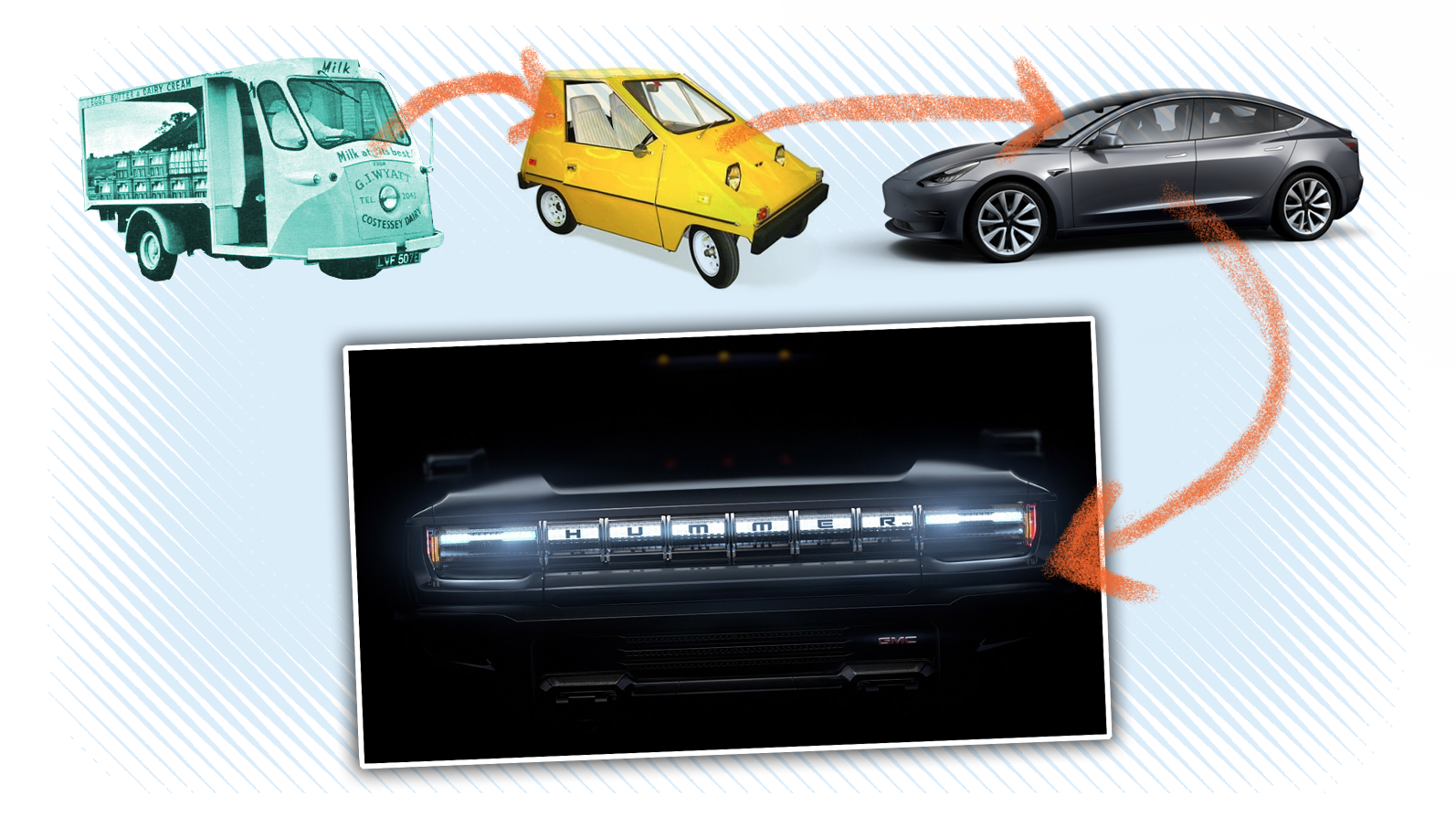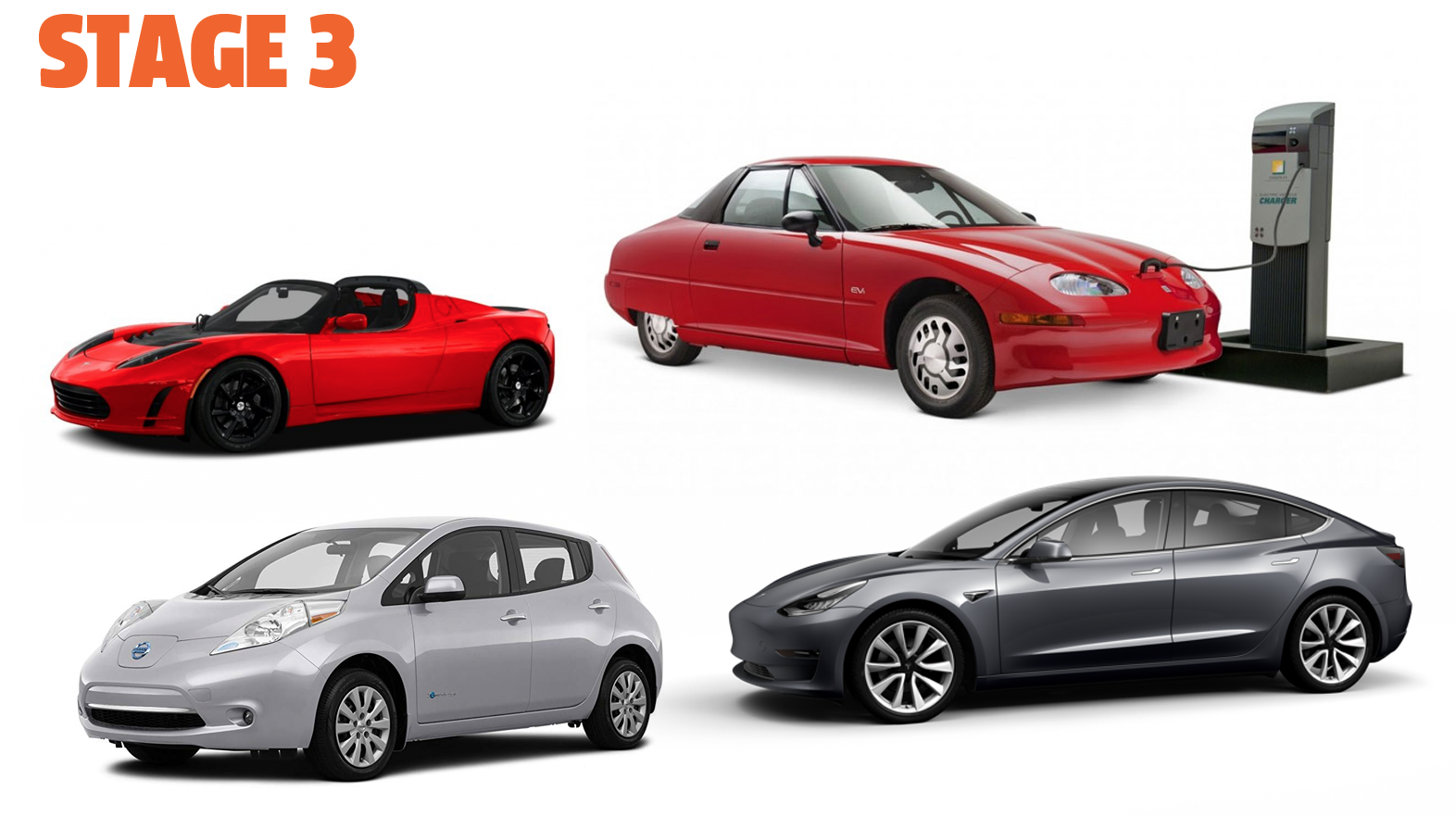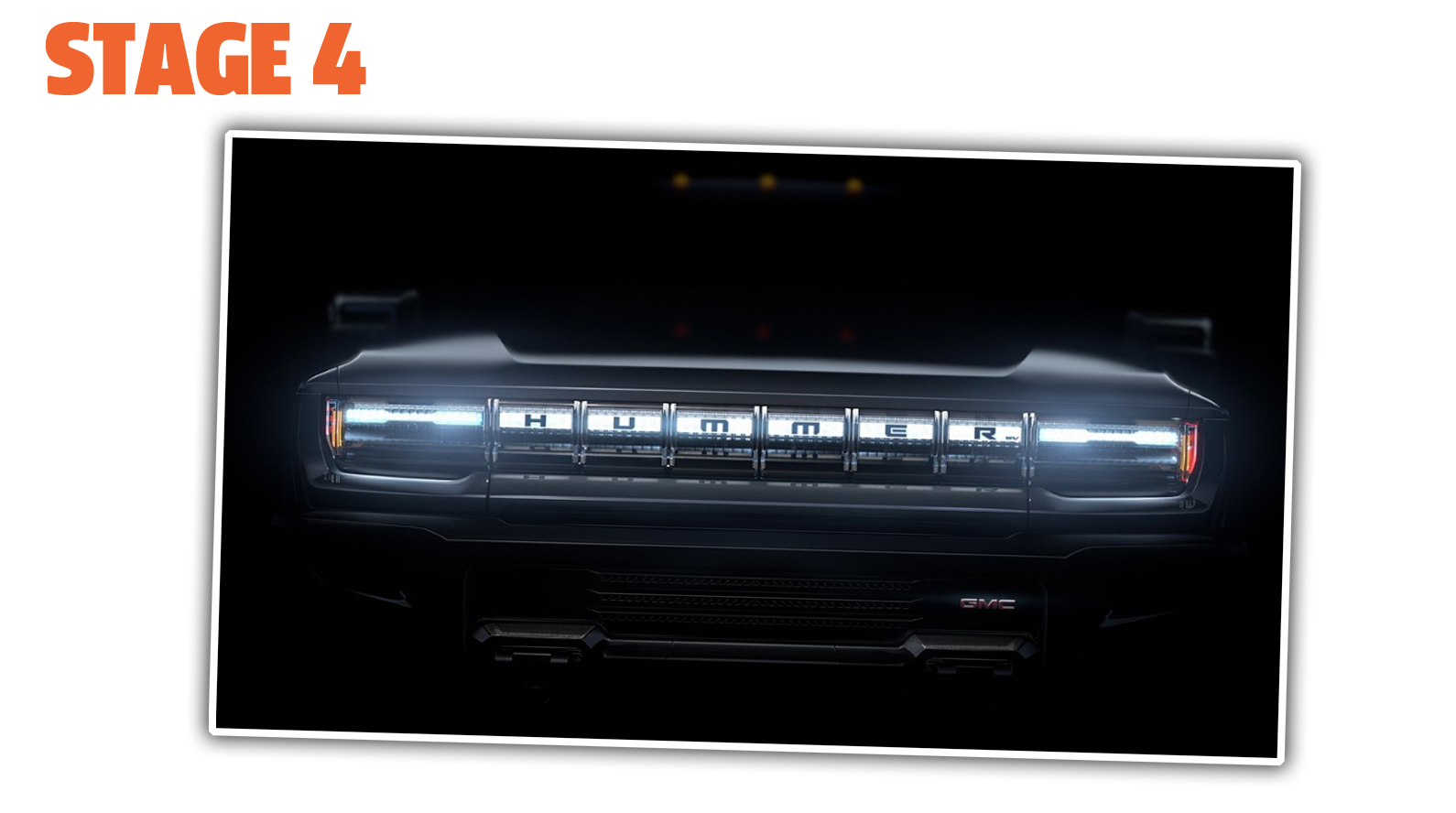Seriously, The Electric Hummer Is A Total Change In How We Think About EVs
by Jason Torchinsky and Jalopnik
As modern as they seem, electric vehicles have actually been around a very long time, since the dawn of the motorcar era at the turn of the 20th century. Even after losing out to gasoline vehicles, they’ve always been around quietly lurking in the background of automobildom. The way we perceive EVs has changed a lot over recent decades, and we’re on the cusp of what may be the biggest conceptual change to EVs yet, and it’s kicked off by this new EV Hummer.
What’s significant about the Hummer tease is not so much what GM chose to reveal, but what they chose not to reveal, and why the absence of certain bits of information that once would have been considered crucial are now no longer so. The fact that this is ok, that they chose to introduce this vehicle like this is evidence of this dramatic shift I’m alluding to.
First, let’s just quickly run through how we got here. Electric vehicle perception has changed an awful lot, and I think has gone through three major stages since the early 1900s heyday of EVs and their subsequent demise to the dominance of the internal combustion engine.
After the 1930s, electric cars were all but extinct on the market, but there was still a bit of residual interest in them, mostly in experimental contexts or as fleet vehicles. This was Stage 1, which I’ll peg as being between the late 1940s to 1960.

For example, in the 1950s the German Post office was trying out some electric delivery vehicles, and in Britain electric milk delivery vans, called Milk Floats, were slowly but consistently delivering dairy goods all over the country. In fact, according to a 1967 issue of Autocar, Britain had more EVs than anywhere else in the world combined, and the vast majority of those were delivering milk.
In this era, EVs were being designed and built to do very specific jobs they were well-suited for: low speed, set-length routes, and plenty of recharging time between use.
Next came the era of attempts to adapt EVs to conventional, everyday personal automotive use. This we’ll call Stage 2, and it was a long period, stretching from the 1960s into the mid-to-late 1990s.

There were a lot of attempts to make things work in this era, and these attempts varied from conversions of conventional vehicles to electric power, like the Renault Dauphines turned into electric Henney Kilowatts, or completely original designs like the CitiCar and many other similar flimsy, small, plastic-bodied commuter vehicles.
Many companies were getting into the EV game at this time, including unexpected organisations like NASA and the Copper Development Association. This was also the era when EVs began to be associated with environmental concerns as a less-ecologically harmful alternative to combustion vehicles.
This stage was when conventional specs like speed and acceleration began to become important, along with more EV-specific numbers like range and recharge time.
This was also the stage when the most damage was done to the perception of EVs, because electric vehicles of this era were almost uniformly awful. Everything about them sucked, and sucked dramatically: they were slow, heavy, had minimal range, took forever to recharge, and were generally miserable.
You would have to be two Ed Begley, Jrs stacked up in an Ed Begley, Jr suit eating pureéd Ed Begley, Jr just to even consider getting inside one of these miserable plastic shitboxes.
Stage 3, which I peg as starting with GM’s revolutionary EV1, and I’m going to end effectively now, but we’ll say 2019. This was the stage that really changed how we perceived EVs, and it’s almost all thanks to Tesla.

Stage 3 was all about breaking down the old EV stigmas instilled into the world from the shitty cars of Stage 2, and re-inventing the EV as something not just efficient or responsible, but actually desirable.
In 1997, GM’s EV1 showed the world what a modern EV could be. While it’s specs aren’t anything impressive today, at the time they were revolutionary. The EV1 could go between 70 to 100 miles per charge, it felt and drove like a real car and not some glorified golf cart, and it was actually kind of quick.
From there we finally started to see real, usable mass-market EVs like the Nissan Leaf, which proved that you could live with and use an EV, and then, in 2012, everything changed with the Tesla Model S, which proved EVs could be actually desirable.
Tesla built EVs that were fast—faster than most gasoline cars, even, comfortable, stylish, and with the Model S, whole decades of golf cart EV stigma began to crumble. This was a huge shift in the perception of EVs, and is largely why Tesla enjoys the status it does: they made EVs sexy.
Of course, during this era, the idea of range was absolutely key, arguably the most important spec for any EV. The concept of “range anxiety” came about because for the first time, enough people were driving EVs to make this issue something to consider.
Average ranges in this period grew from below 100 to over 300 miles; 200 or so miles is now a minimally acceptable range for a modern EV. It was also in this period that the charging infrastructure—though still nowhere near as robust as the gasoline refuelling infrastructure—started to grow and mature into something useful.
So, by the end of Stage 3, EVs have been rehabilitated from sad little plastic karts into status symbols that boasted speed, practicality, and environmentalism, all wrapped up in a high-tech shell.

Now, with this EV Hummer announcement, we’re entering Stage 4. This stage is new for a few key reasons, all of which you can see—or, more accurately, not see— in the EV Hummer announcement.
First, there’s the Hummer name and brand itself, which is about as anti-environmental as one could imagine. The connotation of “Hummer” has always been actively hostile to any sort of ecological awareness, in a very brutal and almost childishly reactionary way. If people drove hybrid Priuses and EV Leafs as a way to say “love the Earth” via their car, then driving a Hummer said “fuck the Earth.”
Next, there’s the specs that were revealed: Incredible numbers like 1,000 horsepower, 0 to 60 mph in three seconds, and that ridiculous 11,500 pound-feet of torque (this is probably wheel torque, but it doesn’t really matter for my point here) and, significantly, absolutely no mention of range.
So, what does this say about the new era of EVs? In a way, they’ve fully arrived into the mainstream, because the same ridiculous things are being boasted about, and the EV-specific traits that were once so important (range numbers and the idea of environmental benefit) are nowhere to be seen.
EVs are now being advertised with the same irrational glee as any car: look how crazy fast this thing is! It’s the same way the Dodge Challenger SRT Demon, that 840 HP street-legal drag car was advertised, yet the two vehicles couldn’t really be more different.
Can you really make use of 1,000 HP in your normal driving? Fuck, no. Is this likely gigantic and heavy-arse SUV going to be great on a track? I seriously doubt it. Will its range actually be important? Absolutely. Will it be more environmentally friendly than the original Hummer? Again, absolutely, though you could probably say the same thing about a small tire fire.
This all means that now EVs are just another kind of car in our minds. They don’t need to have their unique traits pointed out, no matter how important those traits may actually be. We’re now in the era where EVs get promoted and advertised and understood with the same delerious irrationality as any other car out there.
And yes, this is progress, and it’s good. Welcome to Stage 4, everybody, where EVs are as fast and stupid as everything we already love.